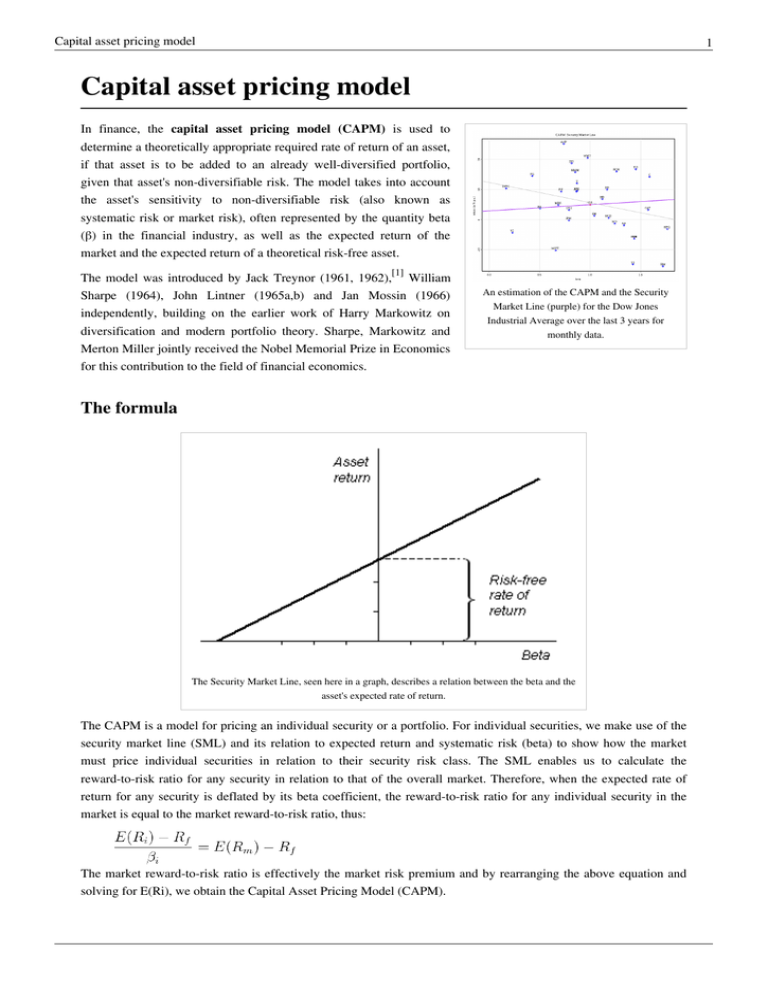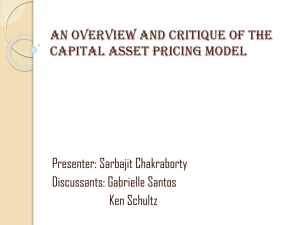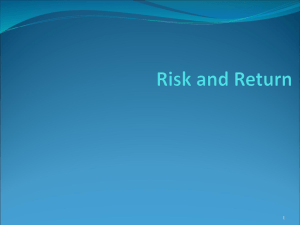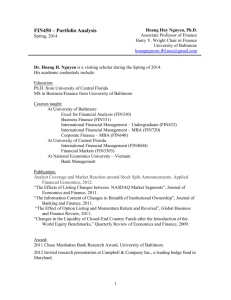Capital asset pricing model
advertisement

Capital asset pricing model 1 Capital asset pricing model In finance, the capital asset pricing model (CAPM) is used to determine a theoretically appropriate required rate of return of an asset, if that asset is to be added to an already well-diversified portfolio, given that asset's non-diversifiable risk. The model takes into account the asset's sensitivity to non-diversifiable risk (also known as systematic risk or market risk), often represented by the quantity beta (β) in the financial industry, as well as the expected return of the market and the expected return of a theoretical risk-free asset. The model was introduced by Jack Treynor (1961, 1962),[1] William Sharpe (1964), John Lintner (1965a,b) and Jan Mossin (1966) independently, building on the earlier work of Harry Markowitz on diversification and modern portfolio theory. Sharpe, Markowitz and Merton Miller jointly received the Nobel Memorial Prize in Economics for this contribution to the field of financial economics. An estimation of the CAPM and the Security Market Line (purple) for the Dow Jones Industrial Average over the last 3 years for monthly data. The formula The Security Market Line, seen here in a graph, describes a relation between the beta and the asset's expected rate of return. The CAPM is a model for pricing an individual security or a portfolio. For individual securities, we make use of the security market line (SML) and its relation to expected return and systematic risk (beta) to show how the market must price individual securities in relation to their security risk class. The SML enables us to calculate the reward-to-risk ratio for any security in relation to that of the overall market. Therefore, when the expected rate of return for any security is deflated by its beta coefficient, the reward-to-risk ratio for any individual security in the market is equal to the market reward-to-risk ratio, thus: The market reward-to-risk ratio is effectively the market risk premium and by rearranging the above equation and solving for E(Ri), we obtain the Capital Asset Pricing Model (CAPM). Capital asset pricing model 2 where: • • • is the expected return on the capital asset is the risk-free rate of interest such as interest arising from government bonds (the beta) is the sensitivity of the expected excess asset returns to the expected excess market returns, or also , • • is the expected return of the market is sometimes known as the market premium or risk premium (the difference between the expected market rate of return and the risk-free rate of return). Restated, in terms of risk premium, we find that: which states that the individual risk premium equals the market premium times β. Note 1: the expected market rate of return is usually estimated by measuring the Geometric Average of the historical returns on a market portfolio (e.g. S&P 500). Note 2: the risk free rate of return used for determining the risk premium is usually the arithmetic average of historical risk free rates of return and not the current risk free rate of return. For the full derivation see Modern portfolio theory. Security market line The SML essentially graphs the results from the capital asset pricing model (CAPM) formula. The x-axis represents the risk (beta), and the y-axis represents the expected return. The market risk premium is determined from the slope of the SML. The relationship between β and required return is plotted on the securities market line (SML) which shows expected return as a function of β. The intercept is the nominal risk-free rate available for the market, while the slope is the market premium, E(Rm)− Rf. The securities market line can be regarded as representing a single-factor model of the asset price, where Beta is exposure to changes in value of the Market. The equation of the SML is thus: It is a useful tool in determining if an asset being considered for a portfolio offers a reasonable expected return for risk. Individual securities are plotted on the SML graph. If the security's expected return versus risk is plotted above the SML, it is undervalued since the investor can expect a greater return for the inherent risk. And a security plotted below the SML is overvalued since the investor would be accepting less return for the amount of risk assumed. Asset pricing Once the expected/required rate of return, , is calculated using CAPM, we can compare this required rate of return to the asset's estimated rate of return over a specific investment horizon to determine whether it would be an appropriate investment. To make this comparison, you need an independent estimate of the return outlook for the security based on either fundamental or technical analysis techniques, including P/E, M/B etc. In theory, therefore, an asset is correctly priced when its estimated price is the same as the required rates of return calculated using the CAPM. If the estimate price is higher than the CAPM valuation, then the asset is undervalued (and overvalued when the estimated price is below the CAPM valuation). Capital asset pricing model 3 Asset-specific required return The CAPM returns the asset-appropriate required return or discount rate—i.e. the rate at which future cash flows produced by the asset should be discounted given that asset's relative riskiness. Betas exceeding one signify more than average "riskiness"; betas below one indicate lower than average. Thus, a more risky stock will have a higher beta and will be discounted at a higher rate; less sensitive stocks will have lower betas and be discounted at a lower rate. Given the accepted concave utility function, the CAPM is consistent with intuition—investors (should) require a higher return for holding a more risky asset. Since beta reflects asset-specific sensitivity to non-diversifiable, i.e. market risk, the market as a whole, by definition, has a beta of one. Stock market indices are frequently used as local proxies for the market—and in that case (by definition) have a beta of one. An investor in a large, diversified portfolio (such as a mutual fund), therefore, expects performance in line with the market. Risk and diversification The risk of a portfolio comprises systematic risk, also known as undiversifiable risk, and unsystematic risk which is also known as idiosyncratic risk or diversifiable risk. Systematic risk refers to the risk common to all securities—i.e. market risk. Unsystematic risk is the risk associated with individual assets. Unsystematic risk can be diversified away to smaller levels by including a greater number of assets in the portfolio (specific risks "average out"). The same is not possible for systematic risk within one market. Depending on the market, a portfolio of approximately 30-40 securities in developed markets such as UK or US will render the portfolio sufficiently diversified such that risk exposure is limited to systematic risk only. In developing markets a larger number is required, due to the higher asset volatilities. A rational investor should not take on any diversifiable risk, as only non-diversifiable risks are rewarded within the scope of this model. Therefore, the required return on an asset, that is, the return that compensates for risk taken, must be linked to its riskiness in a portfolio context - i.e. its contribution to overall portfolio riskiness - as opposed to its "stand alone riskiness." In the CAPM context, portfolio risk is represented by higher variance i.e. less predictability. In other words the beta of the portfolio is the defining factor in rewarding the systematic exposure taken by an investor. The efficient frontier The CAPM assumes that the risk-return profile of a portfolio can be optimized—an optimal portfolio displays the lowest possible level of risk for its level of return. Additionally, since each additional asset introduced into a portfolio further diversifies the portfolio, the optimal portfolio must comprise every asset, (assuming no trading costs) with each asset value-weighted to achieve the above (assuming that any asset is infinitely divisible). All such optimal portfolios, i.e., one for each level of return, comprise the efficient frontier. Because the unsystematic risk is diversifiable, the total risk of a portfolio can be viewed as beta. The (Markowitz) efficient frontier. CAL stands for the capital allocation line. Capital asset pricing model The market portfolio An investor might choose to invest a proportion of his or her wealth in a portfolio of risky assets with the remainder in cash—earning interest at the risk free rate (or indeed may borrow money to fund his or her purchase of risky assets in which case there is a negative cash weighting). Here, the ratio of risky assets to risk free asset does not determine overall return—this relationship is clearly linear. It is thus possible to achieve a particular return in one of two ways: 1. By investing all of one's wealth in a risky portfolio, 2. or by investing a proportion in a risky portfolio and the remainder in cash (either borrowed or invested). For a given level of return, however, only one of these portfolios will be optimal (in the sense of lowest risk). Since the risk free asset is, by definition, uncorrelated with any other asset, option 2 will generally have the lower variance and hence be the more efficient of the two. This relationship also holds for portfolios along the efficient frontier: a higher return portfolio plus cash is more efficient than a lower return portfolio alone for that lower level of return. For a given risk free rate, there is only one optimal portfolio which can be combined with cash to achieve the lowest level of risk for any possible return. This is the market portfolio. Assumptions of CAPM All investors: 1. 2. 3. 4. 5. 6. 7. 8. Aim to maximize economic utilities. Are rational and risk-averse. Are broadly diversified across a range of investments. Are price takers, i.e., they cannot influence prices. Can lend and borrow unlimited amounts under the risk free rate of interest. Trade without transaction or taxation costs. Deal with securities that are all highly divisible into small parcels. Assume all information is available at the same time to all investors. Shortcomings of CAPM • The model assumes that either asset returns are (jointly) normally distributed random variables or that investors employ a quadratic form of utility. It is however frequently observed that returns in equity and other markets are not normally distributed. As a result, large swings (3 to 6 standard deviations from the mean) occur in the market more frequently than the normal distribution assumption would expect.[2] • The model assumes that the variance of returns is an adequate measurement of risk. This might be justified under the assumption of normally distributed returns, but for general return distributions other risk measures (like coherent risk measures) will likely reflect the investors' preferences more adequately. Indeed risk in financial investments is not variance in itself, rather it is the probability of losing: it is asymmetric in nature. • The model assumes that all investors have access to the same information and agree about the risk and expected return of all assets (homogeneous expectations assumption). • The model assumes that the probability beliefs of investors match the true distribution of returns. A different possibility is that investors' expectations are biased, causing market prices to be informationally inefficient. This possibility is studied in the field of behavioral finance, which uses psychological assumptions to provide alternatives to the CAPM such as the overconfidence-based asset pricing model of Kent Daniel, David Hirshleifer, and Avanidhar Subrahmanyam (2001)[3] . • The model does not appear to adequately explain the variation in stock returns. Empirical studies show that low beta stocks may offer higher returns than the model would predict. Some data to this effect was presented as early 4 Capital asset pricing model as a 1969 conference in Buffalo, New York in a paper by Fischer Black, Michael Jensen, and Myron Scholes. Either that fact is itself rational (which saves the efficient-market hypothesis but makes CAPM wrong), or it is irrational (which saves CAPM, but makes the EMH wrong – indeed, this possibility makes volatility arbitrage a strategy for reliably beating the market). • The model assumes that given a certain expected return investors will prefer lower risk (lower variance) to higher risk and conversely given a certain level of risk will prefer higher returns to lower ones. It does not allow for investors who will accept lower returns for higher risk. Casino gamblers clearly pay for risk, and it is possible that some stock traders will pay for risk as well. • The model assumes that there are no taxes or transaction costs, although this assumption may be relaxed with more complicated versions of the model. • The market portfolio consists of all assets in all markets, where each asset is weighted by its market capitalization. This assumes no preference between markets and assets for individual investors, and that investors choose assets solely as a function of their risk-return profile. It also assumes that all assets are infinitely divisible as to the amount which may be held or transacted. • The market portfolio should in theory include all types of assets that are held by anyone as an investment (including works of art, real estate, human capital...) In practice, such a market portfolio is unobservable and people usually substitute a stock index as a proxy for the true market portfolio. Unfortunately, it has been shown that this substitution is not innocuous and can lead to false inferences as to the validity of the CAPM, and it has been said that due to the inobservability of the true market portfolio, the CAPM might not be empirically testable. This was presented in greater depth in a paper by Richard Roll in 1977, and is generally referred to as Roll's critique.[4] • The model assumes just two dates, so that there is no opportunity to consume and rebalance portfolios repeatedly over time. The basic insights of the model are extended and generalized in the intertemporal CAPM (ICAPM) of Robert Merton, and the consumption CAPM (CCAPM) of Douglas Breeden and Mark Rubinstein. • CAPM assumes that all investors will consider all of their assets and optimize one portfolio. This is in sharp contradiction with portfolios that are held by individual investors: humans tend to have fragmented portfolios or, rather, multiple portfolios: for each goal one portfolio — see behavioral portfolio theory [5] and Maslowian Portfolio Theory [6] . See also • • • • • • • • • • Arbitrage pricing theory (APT) Consumption beta (C-CAPM) Efficient market hypothesis Fama-French three-factor model Hamada's equation Modern portfolio theory Risk Risk management tools Roll's critique Valuation (finance) 5 Capital asset pricing model References [1] http:/ / ssrn. com/ abstract=447580 [2] Mandelbrot, B., and Hudson, R. L. (2004). The (Mis)Behaviour of Markets: A Fractal View of Risk, Ruin, and Reward. London: Profile Books. [3] 'Overconfidence, Arbitrage, and Equilibrium Asset Pricing,' Kent D. Daniel, David Hirshleifer and Avanidhar Subrahmanyam, Journal of Finance, 56(3) (June, 2001), pp. 921-965 [4] 'ROLL, R. (1977): “A Critique of the Asset Pricing Theory’s Tests,” Journal of Financial Economics, 4, 129–176. [5] SHEFRIN, H., AND M. STATMAN (2000): “Behavioral Portfolio Theory,” Journal of Financial and Quantitative Analysis, 35(2), 127–151. [6] DE BROUWER, Ph. (2009): “Maslowian Portfolio Theory: An alternative formulation of the Behavioural Portfolio Theory”, Journal of Asset Management, 9 (6), pp. 359–365. Bibliography • Black, Fischer., Michael C. Jensen, and Myron Scholes (1972). The Capital Asset Pricing Model: Some Empirical Tests, pp. 79–121 in M. Jensen ed., Studies in the Theory of Capital Markets. New York: Praeger Publishers. • Fama, Eugene F. (1968). Risk, Return and Equilibrium: Some Clarifying Comments. Journal of Finance Vol. 23, No. 1, pp. 29–40. • Fama, Eugene F. and Kenneth French (1992). The Cross-Section of Expected Stock Returns. Journal of Finance, June 1992, 427-466. • French, Craig W. (2003). The Treynor Capital Asset Pricing Model, Journal of Investment Management, Vol. 1, No. 2, pp. 60–72. Available at http://www.joim.com/ • French, Craig W. (2002). Jack Treynor's 'Toward a Theory of Market Value of Risky Assets' (December). Available at http://ssrn.com/abstract=628187 • Lintner, John (1965). The valuation of risk assets and the selection of risky investments in stock portfolios and capital budgets, Review of Economics and Statistics, 47 (1), 13-37. • Markowitz, Harry M. (1999). The early history of portfolio theory: 1600-1960, Financial Analysts Journal, Vol. 55, No. 4 • Mehrling, Perry (2005). Fischer Black and the Revolutionary Idea of Finance. Hoboken: John Wiley & Sons, Inc. • Mossin, Jan. (1966). Equilibrium in a Capital Asset Market, Econometrica, Vol. 34, No. 4, pp. 768–783. • Ross, Stephen A. (1977). The Capital Asset Pricing Model (CAPM), Short-sale Restrictions and Related Issues, Journal of Finance, 32 (177) • Rubinstein, Mark (2006). A History of the Theory of Investments. Hoboken: John Wiley & Sons, Inc. • Sharpe, William F. (1964). Capital asset prices: A theory of market equilibrium under conditions of risk, Journal of Finance, 19 (3), 425-442 • Stone, Bernell K. (1970) Risk, Return, and Equilibrium: A General Single-Period Theory of Asset Selection and Capital-Market Equilibrium. Cambridge: MIT Press. • Tobin, James (1958). Liquidity preference as behavior towards risk, The Review of Economic Studies, 25 • Treynor, Jack L. (1961). Market Value, Time, and Risk. Unpublished manuscript. • Treynor, Jack L. (1962). Toward a Theory of Market Value of Risky Assets. Unpublished manuscript. A final version was published in 1999, in Asset Pricing and Portfolio Performance: Models, Strategy and Performance Metrics. Robert A. Korajczyk (editor) London: Risk Books, pp. 15–22. • Mullins, David W. (1982). Does the capital asset pricing model work?, Harvard Business Review, January-February 1982, 105-113. 6 Capital asset pricing model External links • Multiasset efficient frontier (http://www.duke.edu/~charvey/frontier/frontier.html) • Yale Lecture on CAPM and Portfolio Diversification (http://academicearth.org/lectures/ portfolio-diversification) • Capital Asset Pricing Model (CAPM) (http://web.mit.edu/15.407/file/Ch11.pdf) 7 Article Sources and Contributors Article Sources and Contributors Capital asset pricing model Source: http://en.wikipedia.org/w/index.php?oldid=388741460 Contributors: A quant, Abh1984, Accounting instructor, Acroterion, Agbr, Alansohn, AlphaPyro, Anonymous101, Argon233, Atlastawake, Avadhutnaik, Avraham, Azxten, BCRCornet, Bhludzin, Bobblehead, CalebNoble, Carax, Cherkash, Chochopk, Choong2, Christofurio, Chrisvls, Clayoquot, Corpx, Crgfrench, Cryout, Cyberevil, DBO, Danausi, Dinnerbone, DocendoDiscimus, EconoPhysicist, Edward, Eldin raigmore, EliteMike, Epbr123, Epktsang, Espenrh, Exliontamer redux, Farmanesh, Feco, Finngall, Fintor, First Harmonic, G2010a, GDonato, GESICC, General agent, Gnixon, Gossg, Hereford3, ImperfectlyInformed, Isnow, Japanese Searobin, Jared Hunt, Jerryseinfeld, Jezzabr, Jni, John Quiggin, John wesley, JohnWest, Jonathanstray, Jusdafax, Killsaids, Kurholio, Kuru, Lamro, Landroni, Lbbzman, Lex9988, Lld2006, Logariasmo, Lupin, MONGO, MSGJ, Macroellen, Marcika, Martg76, Mathaddins, Matthewcpollard, Maurreen, MaxSem, Meeples, Meister Hoora, Meno25, Mfolozi, Michael Hardy, Mlpearc, Mm1972, Molare, MrOllie, Mydogategodshat, Naddy, Nakon, NawlinWiki, Nbarth, Nielses, Ochyou, Oleg Alexandrov, Olivier, Park3r, Paul.Paquette, Paxse, Pgreenfinch, Phdb, Portutusd, Postdlf, Publichealthguru, Qxz, Requestion, RexNL, Rogimoto, Sagarjethani, Sentriclecub, Shawnc, Smallbones, Sun King, Tabrez, Taiemail, TastyPoutine, Thisisdavid, Toasterpastery, Tomeasy, Torrentweb, Tradnor, Trialsanderrors, Tristanreid, Trygfe, Twister nt, User A1, Uzkan, Waseem7, Wlmsears, Zain Ebrahim111, Zenohockey, 374 anonymous edits Image Sources, Licenses and Contributors Image:CAPM-SML.svg Source: http://en.wikipedia.org/w/index.php?title=File:CAPM-SML.svg License: Creative Commons Attribution-Sharealike 2.5 Contributors: Thomas Steiner Image:SecMktLine.png Source: http://en.wikipedia.org/w/index.php?title=File:SecMktLine.png License: unknown Contributors: BenFrantzDale, Derbeth, Mailer diablo, Mfolozi, 1 anonymous edits Image:markowitz frontier.jpg Source: http://en.wikipedia.org/w/index.php?title=File:Markowitz_frontier.jpg License: Public Domain Contributors: BenFrantzDale, Ehn, G2010a, Storkk License Creative Commons Attribution-Share Alike 3.0 Unported http:/ / creativecommons. org/ licenses/ by-sa/ 3. 0/ 8







